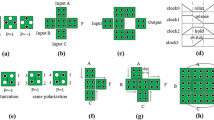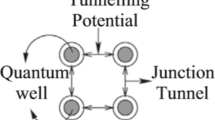Abstract
Since conventional CMOS technology has met its development bottleneck, an alternative technology, quantum-dot cellular automata (QCA), attracted researchers’ attention and was studied extensively. The manufacturing process of QCA, however, is immature for commercial production because of the high defect rate. Seeking for designs that display excellent performance shows significant potentials for practical realizations. In the paper we propose a 5 × 5 module, which not only can implement three-input majority gate but also can realize five-input majority gate by adding another two inputs. A comprehensive analysis is made in terms of area, number of cells, energy dissipation and fault tolerance against single-cell omission defects. In order to testify the superiority of the proposed designs, preexisting related designs are tested and compared. Weighing up above four kinds of factors and technical feasibility, proposed majority gates perform fairly well. Further, we take full adders and multi-bit adders as illustrations to display the practical application of proposed majority gates. The detailed comparisons with previous adders reveal that proposed 5 × 5 module behaves well in circuits, especially the high degree of fault tolerance and the relatively small area, complexity and QCA cost, thereby making it more suitable for practical realizations in large circuit designs.















Similar content being viewed by others
Explore related subjects
Discover the latest articles, news and stories from top researchers in related subjects.References
Akeela R, Wagh MD a five-input majority gate in quantum-dot cellular automata. In: Nanotechnology 2011: electronics, devices, fabrication, MEMS, fluidics and computational - 2011 NSTI nanotechnology conference and expo, NSTI-nanotech 2011, June 13, 2011 - June 16, 2011, Boston, MA, United States, 2011. Technical proceedings of the 2011 NSTI Nanotechnology Conference and Expo, NSTI-Nanotech 2011. Nano Science and Technology Institute, pp 13–16
Angizi S, Alkaldy E, Bagherzadeh N, Navi K (2014) Novel robust single layer wire crossing approach for exclusive OR sum of products logic design with quantum-dot cellular automata. J Low Power Electron 10(2):259–271. https://doi.org/10.1166/jolpe.2014.1320
Beard MJ (2006) Design and simulation of fault-tolerant quantum-dot cellular automata (QCA) NOT gates. Dissertation, Wichita State University
Bernstein GH, Imre A, Metlushko V, Orlov A, Zhou L, Ji L, Csaba G, Porod W (2005) Magnetic QCA systems. Microelectron J 36(7):619–624. https://doi.org/10.1016/j.mejo.2004.12.002
Chaudhary A, Chen DZ, Hu XS, Niemier MT, Ravichandran R, Whitton K (2007) Fabricatable interconnect and molecular QCA circuits. IEEE Trans Comput Aided Des Integr Circuits Syst 26(11):1978–1991. https://doi.org/10.1109/TCAD.2007.906467
Cho H, Swartzlander Jr EE (2009) Adder and multiplier design in quantum-dot cellular automata. IEEE Trans Comput 58(6):721–727. https://doi.org/10.1109/TC.2009.21
Das K, De D (2010) QCA defect and fault analysis of diverse nanostructure for implementing logic gate. International journal of recent trends in. Eng Technol 3(1)
Du H, Lv H, Zhang Y, Peng F, Xie G (2016) Design and analysis of new fault-tolerant majority gate for quantum-dot cellular automata. J Comput Electron 15(4):1484–1497. https://doi.org/10.1007/s10825-016-0918-y
Dysart TJ, M Kogge P (2017) S Lent C. An analysis of missing cell defects in quantum-dot cellular automata, Liu M
Farazkish R (2014) A new quantum-dot cellular automata fault-tolerant five-input majority gate. J Nanopart Res 16(2). https://doi.org/10.1007/s11051-014-2259-8
Farazkish R (2015) A new quantum-dot cellular automata fault-tolerant full-adder. J Comput Electron 14(2):506–514. https://doi.org/10.1007/s10825-015-0668-2
Farazkish R, Khodaparast F (2015) Design and characterization of a new fault-tolerant full-adder for quantum-dot cellular automata. Microprocess Microsyst 39(6):426–433. https://doi.org/10.1016/j.micpro.2015.04.004
Farazkish R, Navi K (2012) New efficient five-input majority gate for quantum-dot cellular automata. J Nanopart Res 14(11):1–6. https://doi.org/10.1007/s11051-012-1252-3
Gin A, Tougaw PD, Williams S (1999) An alternative geometry for quantum-dot cellular automata. J Appl Phys 85(12):8281–8286
Hanninen I, Takala J Robust adders based on quantum-dot cellular automata. In: 2007 I.E. International Conf on Application-specific Systems, Architectures and Processors (ASAP), 9–11 July 2007 2007. pp 391–396. https://doi.org/10.1109/ASAP.2007.4459295
Hayati M, Rezaei A (2015) Design of novel efficient adder and subtractor for quantum-dot cellular automata. Int J Circuit Theory Appl 43(10):1446–1454. https://doi.org/10.1002/cta.2019
Huang J, Momenzadeh M, Lombardi F (2007) On the tolerance to manufacturing defects in molecular QCA tiles for processing-by-wire. J Electron Test Theory Appl (JETTA) 23(2–3):163–174. https://doi.org/10.1007/s10836-006-0548-6
International Technology Roadmap for Semiconductors. (2011). http://www.itrs2.net
Janez M, Pecar P, Mraz M (2012) Layout design of manufacturable quantum-dot cellular automata. Microelectron J 43(7):501–513. https://doi.org/10.1016/j.mejo.2012.03.007
Kassa SR, Nagaria RK (2016) A novel design of quantum dot cellular automata 5-input majority gate with some physical proofs. J Comput Electron 15(1):324–334. https://doi.org/10.1007/s10825-015-0757-2
Kianpour M, Sabbaghi-Nadooshan R, Navi K (2014) A novel design of 8-bit adder/subtractor by quantum-dot cellular automata. J Comput Syst Sci 80(7):1404–1414. https://doi.org/10.1016/j.jcss.2014.04.012
Kim K, Wu K, Karri R (2006) Quantum-dot Cellular Automata design guideline. IEICE Trans Fundam Electron Commun Comput Sci E89-A(6):1607–1614. https://doi.org/10.1093/ietfec/e89-a.6.1607
Krishnaswamy S, Viamontes GF, Markov IL, Hayes JP (2008) Probabilistic transfer matrices in symbolic reliability analysis of logic circuits. ACM Trans Des Autom Electron Syst 13(1). https://doi.org/10.1145/1297666.1297674
Kumar D, Mitra D (2016) Design of a practical fault-tolerant adder in QCA. Microelectron J 53:90–104. https://doi.org/10.1016/j.mejo.2016.04.004
Kummamuru RK, Orlov AO, Ramasubramaniam R, Lent CS, Bernstein GH, Snider GL (2003) Operation of a quantum-dot cellular automata (QCA) shift register and analysis of errors. IEEE Trans Electron Devices 50(9):1906–1913. https://doi.org/10.1109/ted.2003.816522
Lent CS, Tougaw PD (1997) A device architecture for computing with quantum dots. Proc IEEE 85(4):541–557. https://doi.org/10.1109/5.573740
Lent CS, Tougaw PD, Porod W, Bernstein GH (1993) Quantum cellular automata. Nanotechnology 4(1):49–57. https://doi.org/10.1088/0957-4484/4/1/004
Liu W, Lu L, Oneill M, Swartzlander EE (2014) A first step toward cost functions for quantum-dot cellular automata designs. IEEE Trans Nanotechnol 13(3):476–487. https://doi.org/10.1109/TNANO.2014.2306754
Mohammadi M, Mohammadi M, Gorgin S (2016) An efficient design of full adder in quantum-dot cellular automata (QCA) technology. Microelectron J 50:35–43. https://doi.org/10.1016/j.mejo.2016.02.004
Nakagawa S, Eto M, Kawamura K (2001) Dynamic behavior of kink-solitons at junctions in quantum-dot cellular automata. Jpn J Appl Phys Part 1 - Regul Pap Short Notes Rev Pap 40(3B):2046–2049. https://doi.org/10.1143/jjap.40.2046
Navi K, Farazkish R, Sayedsalehi S, Rahimi Azghadi M (2010) A new quantum-dot cellular automata full-adder. Microelectron J 41(12):820–826. https://doi.org/10.1016/j.mejo.2010.07.003
Orlov AO, Amlani I, Toth G, Lent CS, Bernstein GH, Snider GL (1999) Experimental demonstration of a binary wire for quantum-dot cellular automata. Appl Phys Lett 74(19):2875–2877. https://doi.org/10.1063/1.124043
Pudi V, Sridharan K (2012) Low complexity design of ripple carry and Brent-kung adders in QCA. IEEE Trans Nanotechnol 11(1):105–119. https://doi.org/10.1109/TNANO.2011.2158006
Rejimon T, Lingasubramanian K, Bhanja S (2009) Probabilistic error modeling for nano-domain logic circuits. IEEE Trans Very Large Scale Integr VLSI Syst 17(1):55–65. https://doi.org/10.1109/TVLSI.2008.2003167
Roohi A, DeMara RF, Khoshavi N (2015) Design and evaluation of an ultra-area-efficient fault-tolerant QCA full adder. Microelectron J 46(6):531–542. https://doi.org/10.1016/j.mejo.2015.03.023
Sayedsalehi S, Moaiyeri MH, Navi K (2011) Novel efficient adder circuits for quantum-dot cellular automata. J Comput Theor Nanosci 8(9):1769–1775. https://doi.org/10.1166/jctn.2011.1881
Sen BABK (2013) Design of Efficient Full Adder in quantum-dot cellular automata. Sci World J 2013. https://doi.org/10.1155/2013/250802
Sen B, Dutta M, Mukherjee R, Nath RK, Sinha AP, Sikdar BK (2016) Towards the design of hybrid QCA tiles targeting high fault tolerance. J Comput Electron 15(2):429–445. https://doi.org/10.1007/s10825-015-0760-7
Srivastava S, Sarkar S, Bhanja S (2009) Estimation of upper bound of power dissipation in QCA circuits. IEEE Trans Nanotechnol 8(1):116–127. https://doi.org/10.1109/TNANO.2008.2005408
Srivastava S, Asthana A, Bhanja S, Sarkar S QCAPro - An error-power estimation tool for QCA circuit design. In: 2011 I.E. International Symposium of Circuits and Systems, ISCAS 2011, May 15, 2011 - May 18, 2011, Rio de Janeiro, Brazil, 2011. Proceedings - IEEE international symposium on circuits and systems. Institute of Electrical and Electronics Engineers Inc., pp 2377-2380. https://doi.org/10.1109/ISCAS.2011.5938081
Timler J, Lent CS (2002) Power gain and dissipation in quantum-dot cellular automata. J Appl Phys 91(2):823–831. https://doi.org/10.1063/1.1421217
Tougaw PD, Lent CS (1994) Logical devices implemented using quantum cellular automata. J Appl Phys 75(3):1818–1825. https://doi.org/10.1063/1.356375
Vankamamidi V, Ottavi M, Lombardi F (2008) Two-dimensional schemes for clocking/timing of QCA circuits. IEEE Trans Comput Aided Des Integr Circuits Syst 27(1):34–44. https://doi.org/10.1109/TCAD.2007.907020
Walus K, Dysart TJ, Jullien GA, Budiman RA (2004) QCADesigner: a rapid design and simulation tool for quantum-dot cellular automata. IEEE Trans Nanotechnol 3(1):26–31. https://doi.org/10.1109/TNANO.2003.820815
Wang W, Walus K, Jullien GA Quantum-dot cellular automata adders. In: 2003 3rd IEEE Conference on Nanotechnology, IEEE-NANO 2003, August 12, 2003 - August 14, 2003, San Francisco, CA, United states, 2003. Proceedings of the IEEE Conference on Nanotechnology. IEEE Computer Society, pp 461–464. https://doi.org/10.1109/NANO.2003.1231818
Wolkow RA, Livadaru L, Pitters J, Taucer M, Piva P, Salomons M, Cloutier M, Martins BVC Silicon atomic quantum dots enable beyond-CMOS electronics. In: 2013 Workshop on field-coupled Nanocomputing, FCN 2013, February 7, 2013 - February 8, 2013, Tampa, FL, United States, 2014. Lecture notes in computer science (including subseries lecture notes in artificial intelligence and lecture notes in bioinformatics). Springer Verlag, pp 33-58. https://doi.org/10.1007/978-3-662-43722-3_3
Zhang R, Walus K, Wang W, Jullien GA Performance comparison of quantum-dot cellular automata adders. In: IEEE International Symposium on Circuits and Systems 2005, ISCAS 2005, May 23, 2005 - May 26, 2005, Kobe, Japan, 2005. Proceedings - IEEE International Symposium on Circuits and Systems. Institute of Electrical and Electronics Engineers Inc., pp 2522–2526. https://doi.org/10.1109/ISCAS.2005.1465139
Zhang Y, Lv H, Liu S, Xiang Y, Xie G (2015) Defect-tolerance analysis of fundamental quantum-dot cellular automata devices. J Eng 2015. https://doi.org/10.1049/joe.2014.0344
Zhang Y, Lv H, Liu S, Xiang Y, Xie G (2015) Design of quantum-dot cellular automata circuits using five-input majority gate. J Comput Theor Nanosci 12(10):3675–3681. https://doi.org/10.1166/jctn.2015.4259
Zhang Y, Lv H, Du H, Huang C, Liu S, Xie G (2016) Modular design of QCA carry flow adders and multiplier with reduced wire crossing and number of logic gates. Int J Circuit Theory Appl 44(7):1351–1366. https://doi.org/10.1002/cta.2163
Acknowledgment
This work is supported by the National Natural Science Foundation of China (No. 61271122).
Author information
Authors and Affiliations
Corresponding author
Additional information
Responsible Editor: C. Metra
Rights and permissions
About this article
Cite this article
Sun, M., Lv, H., Zhang, Y. et al. The Fundamental Primitives with Fault-Tolerance in Quantum-Dot Cellular Automata. J Electron Test 34, 109–122 (2018). https://doi.org/10.1007/s10836-018-5723-z
Received:
Accepted:
Published:
Issue Date:
DOI: https://doi.org/10.1007/s10836-018-5723-z




